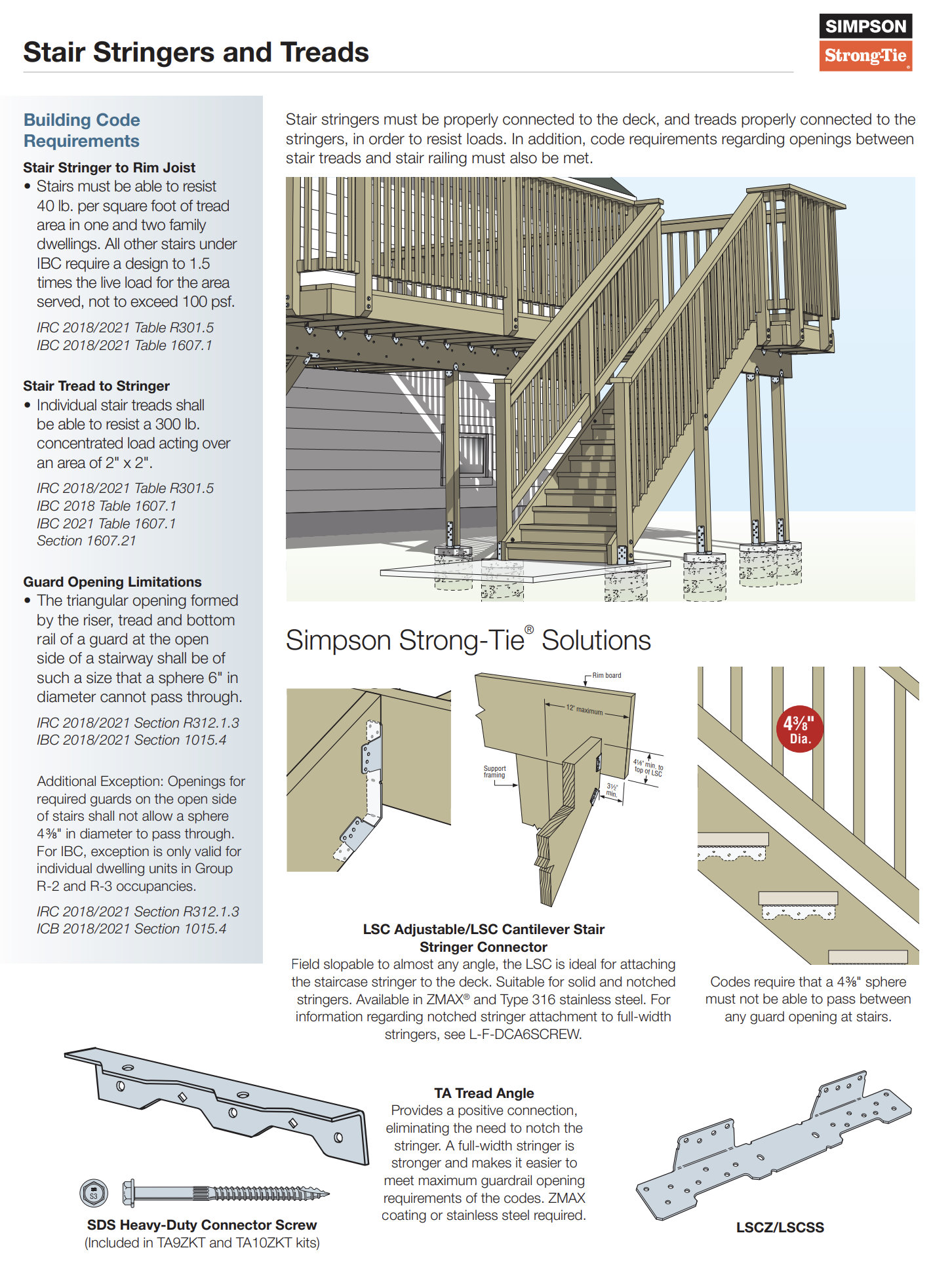Properly connecting stair stringers to the deck and treads to the stringers is crucial for the stability and safety of your deck. Additionally, adhering to building code requirements regarding openings between stair treads and stair railings is essential. This blog will cover the key aspects of deck stair stringer and tread connections, building code requirements, and Simpson Strong-Tie solutions.
Importance of Proper Stair Stringer and Tread Connections
Stair stringers and treads must be securely connected to ensure the stairs can resist loads and provide safe passage. Improper connections can lead to structural failures, posing significant safety hazards.
Building Code Requirements for Stair Stringers and Treads
Stair Stringer to Rim Joist
Stair stringers must be able to resist specific loads to ensure stability and safety.
- Load Resistance: Stairs must resist 40 lb. per square foot of tread area in one- and two-family dwellings. Other stairs under IBC require a design to 1.5 times the live load for the area served, not to exceed 100 psf.
- IRC 2018/2021 Table R301.5
- IBC 2018/2021 Table 1607.1
Stair Tread to Stringer
Individual stair treads must also meet load resistance requirements.
- Load Resistance: Individual stair treads must resist a 300 lb. concentrated load over an area of 2″ x 2″.
- IRC 2018/2021 Table R301.5
- IBC 2018 Table 1607.1
- IBC 2021 Table 1607.1 Section 1607.21
Guard Opening Limitations
Openings between stair treads and stair railings must comply with specific size limitations to prevent accidents.
- Triangular Opening Size: The triangular opening formed by the riser, tread, and bottom rail of a guard at the open side of a stairway must not allow a sphere 6″ in diameter to pass through.
- IRC 2018/2021 Section R312.1.3
- IBC 2018/2021 Section 1015.4
- Guard Openings for Stairs: Openings for required guards on the open side of stairs must not allow a sphere 4⅜” in diameter to pass through. This exception is valid for individual dwelling units in Group R-2 and R-3 occupancies.
- IRC 2018/2021 Section R312.1.3
- IBC 2018/2021 Section 1015.4
Simpson Strong-Tie Solutions for Stair Stringers and Treads
LSC Adjustable/LSC Cantilever Stair Stringer Connector
The LSC connector is field slopable to almost any angle, making it ideal for attaching the staircase stringer to the deck. It is suitable for both solid and notched stringers and is available in ZMAX® and Type 316 stainless steel.
- Features: Adjustable for various angles, suitable for solid and notched stringers.
- Materials: Available in ZMAX® and Type 316 stainless steel.
- Additional Info: For information on notched stringer attachment to full-width stringers, refer to L-F-DCA6SCREW.
TA Tread Angle
The TA Tread Angle provides a positive connection, eliminating the need to notch the stringer. Using a full-width stringer is stronger and helps meet maximum guardrail opening requirements.
- Features: Positive connection, eliminates the need for notching the stringer.
- Materials: Requires ZMAX coating or stainless steel.
- Included Fasteners: SDS Heavy-Duty Connector Screw (included in TA9ZKT and TA10ZKT kits).
Conclusion
Properly connecting stair stringers and treads is crucial for building a safe and durable deck. By adhering to building code requirements and using high-quality solutions from Simpson Strong-Tie, such as the LSC Adjustable Stair Stringer Connector and TA Tread Angle, you can ensure your deck stairs are secure and compliant. Always consult with a qualified professional to verify that your deck’s stair connections meet all necessary standards.
For immediate service or consultation, you may contact us at Allied Emergency Services, INC.
Contact Information:
- Phone: 1-800-792-0212
- Email: Info@AlliedEmergencyServices.com
- Location: Serving Illinois, Wisconsin, and Indiana with a focus on the greater Chicago area.
If you require immediate assistance or have specific questions, our human support is readily available to help you.
Disclaimer: This article is intended for informational purposes only. For professional advice, consult experts in the field.










